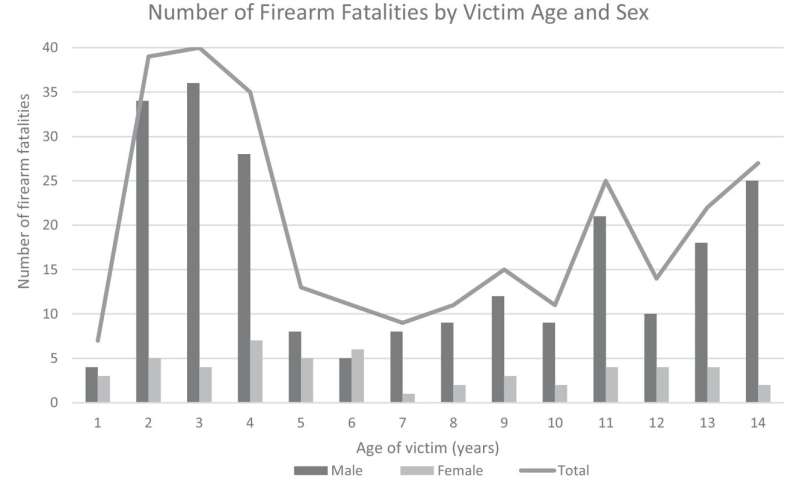Study shows unsafe storage of firearms continues to put guns in the hands of children

Firearms are the leading cause of death among children and teens 1–19 years old in the United States. According to new research from Nationwide Children's Hospital, most unintentional firearm fatalities in which a child shoots another child involve boys, occur in the child's home or at the home of a friend, and involve firearms that were stored loaded and unlocked.
In a new study, researchers at the Center for Injury Research and Policy at Nationwide Children's Hospital analyzed 10 years of data from the National Violent Death Reporting System (NVDRS) on unintentional firearm fatalities among children to investigate cases in which children younger than 15 years old unintentionally killed themselves or another child with a firearm. The authors identified characteristics of victims and the children who inflicted the deaths, their relationship and circumstances of the deaths. The dataset, which does not include all fatalities in the U.S., contained 279 firearm fatalities from 2009 through 2018 that met the study criteria.
The study, published in Injury Epidemiology, found that the majority (81%) of victims were male, and 41% were 2–4 years old. About half (51%) of the victims were White, non-Hispanic, and 40% were Black, non-Hispanic. Overall, most (64%) incidents occurred at the victim's residence, although notably 18% of fatalities among children 10–14 years old occurred at the residence of a friend of the victim.
More than half (57%) of unintentional firearm fatalities in this study were self-inflicted. Among self-inflicted unintentional firearm deaths, the average age of victims was 5.9 years, although children who died of self-inflicted injuries ranged in age from 1 to 14 years old. In the younger than 5 years age group, 80% of the injuries were self-inflicted, compared with 43% in the 5–9 years old age group and 36% in the 10–14 years old age group.
Among cases in which the gun was fired by another child, that child was most commonly the victim's brother (50%). Approximately one-third (32%) of shooters who unintentionally killed a child in the 10–14 years old age group were a friend of the victim, while victims in the younger than 5 years old age group who were shot by others were most commonly shot by a brother (14%). Among the cases in which the gun was fired by another child, the average age of the child who fired the weapon was 9.9 years, and 64% of these children were 10–14 years old. Most shooters were male (93%), 50% were White, and 28% were Black.
When information about how the firearm was stored was available (roughly half of cases), most firearms were stored loaded (92%) and unlocked (92%). Playing with the firearm or mistaking the firearm for a toy were the most common circumstances in these cases (53%). When information about the firearm owner was known, in 81% of cases the owner was a relative of the shooter, often (61%) a parent.
"These results indicate that children are accessing firearms at a home—often their own home—and many of these firearms are not stored safely, even when there are young children in the home. These study findings also highlight that children are accessing firearms belonging to other relatives, not just their parents," said Nichole Michaels, Ph.D., senior author of this study and principal investigator in the Center for Injury Research and Policy.
"When children are killed by another child with a firearm, it has a ripple effect that can impact the well-being of their families, friends, classmates, and communities. In cases like these, it's especially important that we consider the mental health impact of the shooting on the child who unintentionally took the life of another and has to live with the consequences."
Keeping firearms safely stored and out of the hands of children is key to preventing these deaths. Other studies have shown that policies that mandate gun locks and safe storage have been associated with a reduction in adolescent firearm-related suicides and unintentional firearm fatalities among young children. Additionally, child access prevention laws that penalize adults for unsafe storage of firearms can help prevent children from accessing firearms in their home and other residences.
"Although unintentional firearm injuries only comprise about 5% of all firearm deaths among children in the U.S., this study highlights that these fatalities have common characteristics that should be considered when developing strategies to prevent these deaths," said Michaels. "By using a public health approach and treating firearm injuries the same way we treat other causes of child injury, we can prevent these fatalities."
Injuries and deaths from firearms are preventable. The American Academy of Pediatrics (AAP) advises that the safest home for a child is one without firearms. Researchers and the AAP recommend families and caregivers take the following steps to reduce the risk of firearm-related unintentional injury or death:
- Store firearms safely. If removing firearms from the home is not an option, store firearms safely: unloaded, and locked away separately from ammunition.
- Ask about firearms. Before a child goes to a friend's or relative's house, parents and caregivers should ask: "My kid is pretty curious and our doctor recommended that I ask—is there an unlocked gun where he/she will play?" Most parents would be comfortable with being asked about a firearm in their home. Have these conversations before dropping a child off, the same way families would ask about pets in the home or certain foods if a child has allergies.
- Pediatricians and clinicians should include firearm safety in anticipatory guidance, similar to how they provide counseling on car seats and bike helmets. AAP recommends counseling parents on the dangers of firearms in the home and firearm safety. AAP emphasizes a harm-reduction approach, taking into consideration parental beliefs, values, and reasons for firearms ownership.
More information:
Arti Vaishnav et al, An epidemiological study of unintentional pediatric firearm fatalities in the USA, 2009–2018, Injury Epidemiology (2023). DOI: 10.1186/s40621-023-00438-5
Provided by Nationwide Children's Hospital